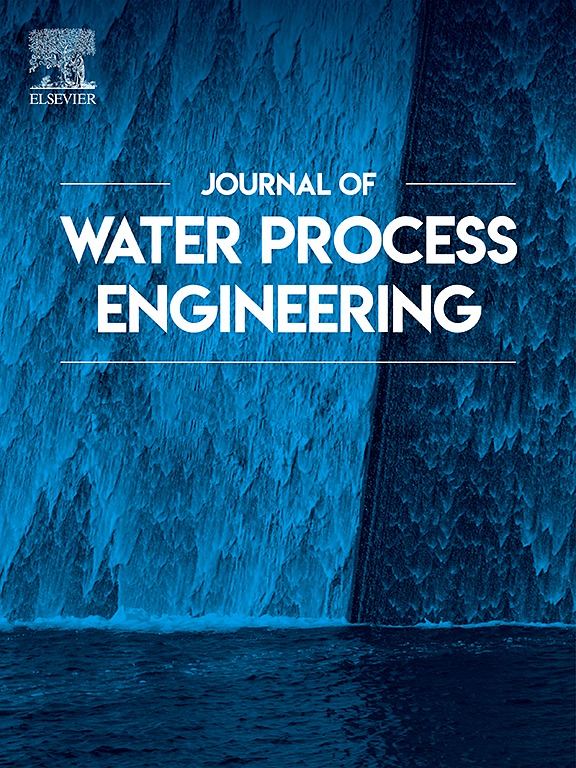S-scheme Fe2O3/TiO2异质结光催化剂的水处理/处理具有优异的抗生素降解/CO2还原/H2生成;流程优化和机制洞察
IF 6.3
2区 工程技术
Q1 ENGINEERING, CHEMICAL
引用次数: 0
摘要
采用简易合成方法制备了Fe2O3/TiO2二元纳米复合材料(FeTi4-400),在可见光下增强了光催化制氢、降解头孢氨苄和还原CO2。与原始TiO2相比,FeTi4-400表现出更好的可见光吸收和促进电荷载流子分离,从而提高了H2生成速率和CO2转化为CH4和CO的速率。这种改善可归因于s型异质结的形成,以及FeTi4-400的理想性能,包括可见光活性、高表面积和强CO2吸附。该光催化剂最大产氢速率为649 μmol/g·h−1,超过了纯TiO2。FeTi4-400的CO产率最高,为16.44 μmol/g·h−1。在最佳条件下,FeTi4-400对头孢氨苄的降解率为96%,降解速率为0.01 min−1。提出了一种合理的头孢氨苄在FeTi4-400上的降解途径。瞬态光电流测量和EIS分析证实了FeTi4-400的光催化活性显著增强,这是由于光电子-空穴对的有效分离。稳定性研究表明,FeTi4-400在连续5个循环中降解头孢氨苄是一致的,没有明显的光催化剂失活。本研究提出了一种制造低成本、高效、易于合成的纳米材料的新策略,用于太阳能转换和环境修复。本文章由计算机程序翻译,如有差异,请以英文原文为准。
Water process/treatment by a S-scheme Fe2O3/TiO2 heterojunction photocatalyst for excellent antibiotic degradation/CO2 reduction/H2 production; process optimization and mechanistic insights
A facile synthesis approach was employed to fabricate a binary Fe2O3/TiO2 nanocomposite (FeTi4-400) for enhanced photocatalytic hydrogen (H2) production, cephalexin degradation and CO2 reduction under visible light irradiation. Compared to pristine TiO2, FeTi4-400 exhibited improved visible light absorption and promoted charge carrier separation, leading to increased H2 production rate and CO2 conversion into CH4 and CO. This improvement can be attributed to the formation of an S-scheme heterojunction, along with the desirable properties of FeTi4-400, including visible light activity, high surface area, and strong CO2 adsorption. The photocatalyst achieved a maximum H2 production rate of 649 μmol/g·h−1, exceeding that of pure TiO2. Similarly, the highest CO production rate of 16.44 μmol/g·h−1 was attained with FeTi4-400. Furthermore, FeTi4-400 achieved excellent cephalexin degradation (96 %) under optimal conditions, with a degradation rate constant of 0.01 min−1. A plausible cephalexin degradation pathway over FeTi4-400 is proposed. Transient photocurrent measurements and EIS analysis corroborated a significant enhancement in photocatalytic activity for FeTi4-400, attributed to the efficient separation of photogenerated electron-hole pairs. Stability studies demonstrated consistent cephalexin degradation by FeTi4-400 over five consecutive cycles without noticeable photocatalyst deactivation. This work presents a novel strategy for fabricating low-cost, efficient, and readily synthesized nanomaterials for applications in solar energy conversion and environmental remediation.
求助全文
通过发布文献求助,成功后即可免费获取论文全文。
去求助
来源期刊

Journal of water process engineering
Biochemistry, Genetics and Molecular Biology-Biotechnology
CiteScore
10.70
自引率
8.60%
发文量
846
审稿时长
24 days
期刊介绍:
The Journal of Water Process Engineering aims to publish refereed, high-quality research papers with significant novelty and impact in all areas of the engineering of water and wastewater processing . Papers on advanced and novel treatment processes and technologies are particularly welcome. The Journal considers papers in areas such as nanotechnology and biotechnology applications in water, novel oxidation and separation processes, membrane processes (except those for desalination) , catalytic processes for the removal of water contaminants, sustainable processes, water reuse and recycling, water use and wastewater minimization, integrated/hybrid technology, process modeling of water treatment and novel treatment processes. Submissions on the subject of adsorbents, including standard measurements of adsorption kinetics and equilibrium will only be considered if there is a genuine case for novelty and contribution, for example highly novel, sustainable adsorbents and their use: papers on activated carbon-type materials derived from natural matter, or surfactant-modified clays and related minerals, would not fulfil this criterion. The Journal particularly welcomes contributions involving environmentally, economically and socially sustainable technology for water treatment, including those which are energy-efficient, with minimal or no chemical consumption, and capable of water recycling and reuse that minimizes the direct disposal of wastewater to the aquatic environment. Papers that describe novel ideas for solving issues related to water quality and availability are also welcome, as are those that show the transfer of techniques from other disciplines. The Journal will consider papers dealing with processes for various water matrices including drinking water (except desalination), domestic, urban and industrial wastewaters, in addition to their residues. It is expected that the journal will be of particular relevance to chemical and process engineers working in the field. The Journal welcomes Full Text papers, Short Communications, State-of-the-Art Reviews and Letters to Editors and Case Studies
 求助内容:
求助内容: 应助结果提醒方式:
应助结果提醒方式:


